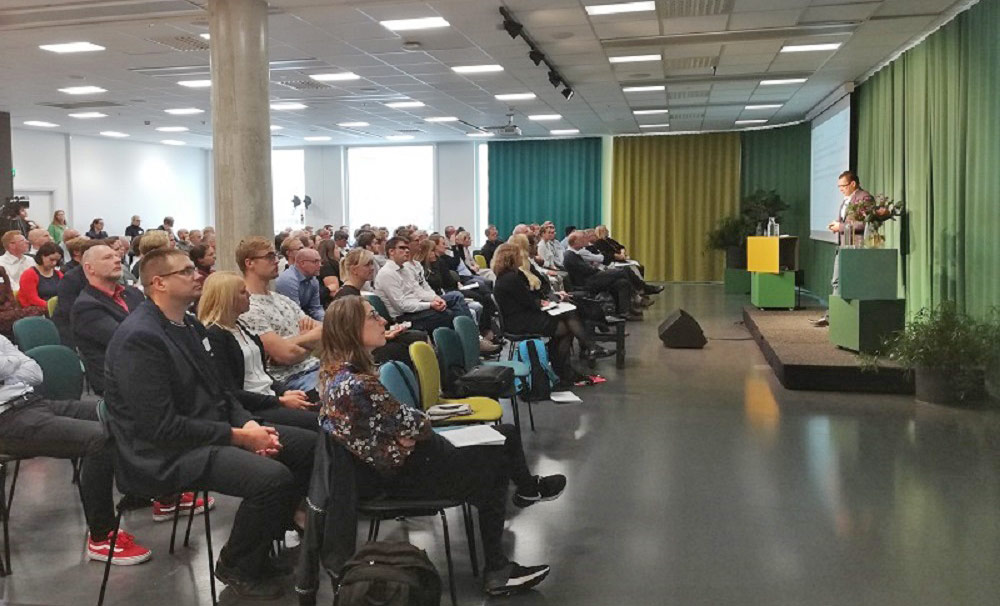Efficient district heating systems are an important component to achieve sustainable energy supply and thus contribute to reduced energy waste and greenhouse gas (CO2) emissions. The LowTEMP Conference brought together district heating companies, suppliers, municipalities and the academic sector to exchange about similar challenges when developing 4th generation district heating. The Conference was organised by the Swedish network Sustainable Business Hub and the Swedish energy supplier Kraftringen supported by the Interreg Baltic Sea Region project LowTEMP.
Professor Sven Werner from Halmstad University in Sweden started the Conference by pointing out that this is not the first time district heating is undergoing a shift. When today’s district heating, the 3rd generation, was developed, Sweden was at the forefront of that movement. It was designed for fossil fuels and high temperatures that are easy to produce and to deliver. He pointed out that today and in the future, most energy sources will be low-temperature with heat from cooling plants and waste, geothermal and solar energy.
Professor Kerstin Sernhed from Lund University in Sweden recalled that the challenges are different depending on whether the subject is district heating for new properties, new district heating for existing buildings or a reduction in the temperature in existing networks. “We must challenge the old way of building district heating from many aspects. We need to look at new materials, new design, new standards, new installations, new players and new business models”, Kerstin Sernhed emphasised.
In line with the need for a modernised district heating system, the LowTEMP project promotes smart and future-oriented heating supply technologies using low temperature grid structures. Britta Schmigotzki, aconium GmbH project manager of the LowTEMP project, stressed the importance of increasing know-how on low-temperature district heating. One of the outputs of the project will be a training programme, including a District Heating Knowledge Platform, providing information on the planning, installation and management of low temperature district heating systems.
Several speakers emphasised the importance of waste heat as a heat source. Reto Michael Hummelshøj, COWI Denmark, presented the Österby project where an existing district heating network was converted into a low temperature system. There, the local shopping center’s excess energy serves the district heating network. Sara Kralmark from the Swedish energy supplier Kraftringen reported that for a low temperature grid at Brunnshög waste heat from the Swedish MAX IV synchrotron radiation laboratory facility in Lund will be used. This grid will be the world’s largest low temperature district heating network.
3rd generation district heating will continue to function in parallel for a long time. However, they can be altered to be more energy efficient by lowering the supply temperature. Smart digital temperature optimisation systems can be of great help here.
The conference also highlighted another advantage of low temperature systems: they allow for the use of plastic pipes instead of metal pipes, thus being more cost effective and flexible. Unlike metal pipes, they can come in long sections, take up less space and have no weld.
The conference concluded with a wish for a common knowledge sharing platform – a well-received feedback for the LowTEMP partners, who joined forces to achieve capacity building in the field of smart and sustainable district heating.
All presentations and a livestream of the Conference can be downloaded from the LowTEMP Website.
Background:
LowTEMP is supported by the European Union (European Regional Development Fund and European Neighbourhood Instrument) under the Interreg Baltic Sea Programme 2014-2020. Interreg enables transnational cooperation to tackle common challenges that do not stop at national borders, such as the rising carbon footprint. The LowTEMP project partners come from Poland, Germany, Denmark, Sweden, Finland, Estonia, Lithuania, Latvia and Russia.
The LowTEMP project contributes to the objectives of the EU2020 strategy by promoting energy efficiency, the use of renewable energy sources and the reduction of CO2 emissions. It also makes important contributions to the objectives of national and European spatial development policies and to the EU Strategy for the Baltic Sea Region (EUSBSR).
The aconium GmbH developed the project on behalf of the Lead Partner IMP AN (Institute of Fluid-flow Machinery, Polish Academy of Sciences) and is responsible for the project, financial and communication management. The aconium GmbH was co-organising the Conference.

